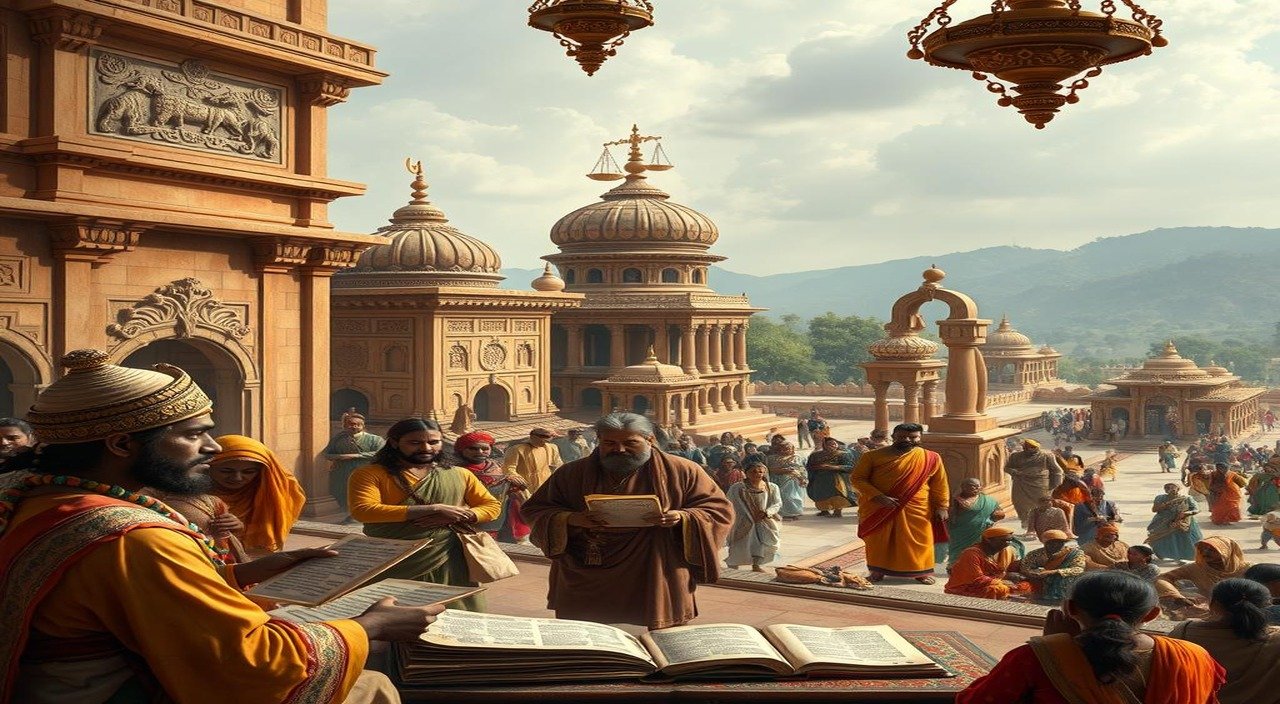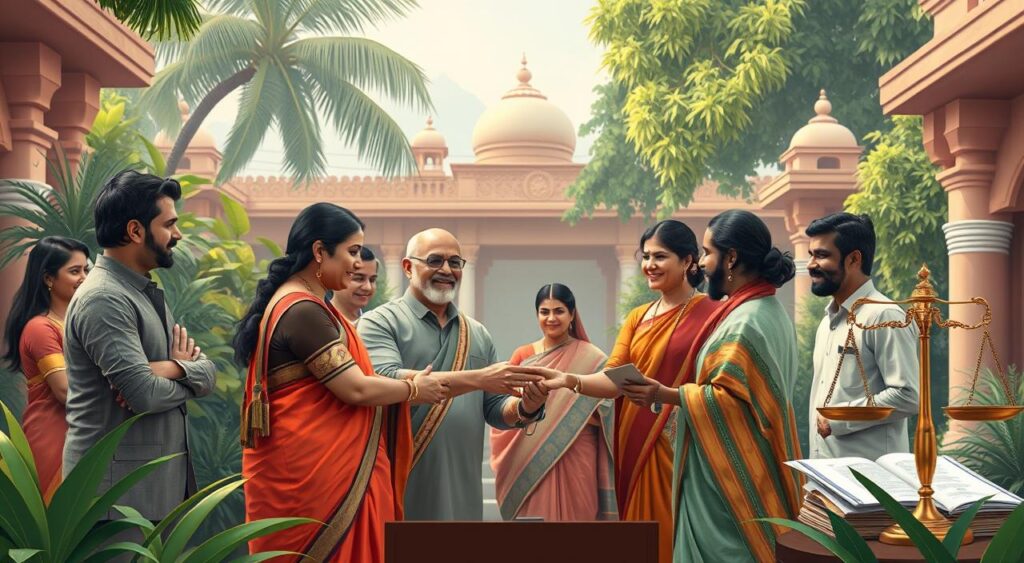Trending

Origin of Law in India is an interesting tale that mixes old customs, religious effects, and colonial remnants. From the Indus Valley to today, Indian law reflects the deep culture of the country and its ability to adapt over time. Looking at how law began and grew has indeed provided us with useful insights into how legal systems have been molded and how they have molded cultural, economic, and political growth. It helps us understand the active give-and-take between social values and legal rules, preparing us to meet today’s legal issues head-on
Law is a collection of rules or principles governing the way people live in societies. It keeps things in order, ensures that things are fair, and looks after the rights of individuals or groups. The concept of law has been in existence as long as civilization, changing with the society as it evolves to meet its new needs. You can think of law as the set of rules set by those in charge, recognised and enforced by courts, which keep society in check.
Keeping Order: Laws form an outline for arranging society forestall chaos and lawlessness.
Fairness: They manage to have things fair by establishing set guidelines on how people should behave and also resolving disputes.
Guarding Rights: Laws protect individual freedoms and group interests, helping everyone get along.
Law plays a big role in how societies function. It maintains justice as fair, creates trust in how we are governed, and allows us to solve our problems without having to fight. Countries with a strong law usually tend to be more stable, fair, and well off.
Hammurabi’s Code circa 1754 BCE
This is one of the oldest known sets of laws, coming from Babylon. This collection of rules and punishments spelled it all out for people and showed how much they cared about justice and keeping things in order.
Roman Law and How It Influenced Things
Roman law the Twelve Tables and later collections like Justinian’s Corpus Juris Civilis set the pattern for modern civil law systems. It was designed to be clear and coherent.
Laws Based on Religion
Canon Law: Governed church affairs in Christian countries.
Sharia: Islamic law from the Quran and Hadith combining faith and rule.
Emergence of Common Law and Civil Law Systems
Common Law: From England common law developed through the judge’s decisions emphasizing past precedents and diversity.
Civil Law: Derived from the Roman law civil law systems are predicated upon comprehensive legal codes focusing on precise rules of law.
A strong link exists in the legal history of India to ancient texts and traditions. They have shaped Indian laws for quite a long time. Main texts in Hinduism, known as the Vedas, initiated the concept of Vedic law which early Indian laws borrowed from.
The Vedas consist of the Rigveda, Samaveda, Yajurveda, and Atharvaveda, and they initiated certain fundamental ideas. They guided the development of ancient Indian jurisprudence. These compositions covered many topics, including rituals, social conventions, and ethics constructing a broad framework for society.

A strong link exists in the legal history of India to ancient texts and traditions. They have shaped Indian laws for quite a long time. Main texts in Hinduism, known as the Vedas, initiated the concept of Vedic law which early Indian laws borrowed from.
The Vedas consist of the Rigveda, Samaveda, Yajurveda, and Atharvaveda, and they initiated certain fundamental ideas. They guided the development of ancient Indian jurisprudence. These compositions covered many topics, including rituals, social conventions, and ethics constructing a broad framework for society.
Dharmashastra is a body of detailed rules that played a great role in forming laws in ancient India. It included writings such as Manusmriti and Yajnavalkya Smriti. Laws regarding social, religious, and ethical code rules for life governed by Vedic law formed an important part of India’s legal tradition.
In old Indian laws, the concept of Raja Dharma, or the responsibilities of the king, was held of paramount importance. The Dharmashastra and other writings defined the king’s duties in terms of morality and ethics. They underscored the need for a just ruler who ensured the safety of citizens and conformed to Dharma, right behavior. These old laws, which had their roots in the Vedas and Dharmashastra, were the benchmarking of Indian legal thinking and continue to impact the legal frameworks in the country today.

Islamic law has contributed to India’s legal history during the Mughal period. This impacted the country’s courts and personal laws in the long term. The Mughal rulers supported art, literature, and architecture. They also influenced India’s legal system. The legal structure of Mughals borrowed elements of Sharia law from India. This combined Islamic legal principles with existing laws. Muslim personal law was born with the Mughal system of law in India. They touched upon issues such as marriage, divorce, inheritance, and guardianship for Muslims.
This body of personal laws based on the Mughal law, grew and developed the legal landscape after the period of colonization. To incorporate these personal laws into India’s legal framework has spurred debate and brought about the need for change in Indian law.
As India aims to balance its diverse legal traditions, the legacy of Islamic law’s integration plays a crucial role in its legal development.
“The integration of Islamic legal principles into the Indian legal system has been a complex and multifaceted process, shaping the country’s jurisprudence in profound ways.”
British colonial rule had a profound impact on Indian law. It established the common law system, which would change the way laws were made and implemented. It was a significant shift for Indian law.
The British brought their own customs of law to India. The common law system, which is based upon precedents and rulings from case to case, superseded the earlier legal systems. It resulted in a much more regulated and formalized process of law.

Major Legal Reforms Under British Rule.
• Codification of laws: The British brought in the Indian Penal Code and the Indian Contract Act. These laws helped set up a more structured legal system.
• Court system: The British established a court system with the High Courts and the Supreme Court as the highest authority. This was different from how justice was earlier meted out.
•Law schools and the legal profession: The British established law schools as well as aided in the development of the legal profession. This largely determined the face of India’s legal spectrum for many decades. The British integrated comprehensive civil and criminal codes into Indian law. The Indian Penal Code, enacted in 1860, and the Indian Contract Act, enacted in 1872, are significant statues in the common law in India. The codes have created a distinct mark on the British reform-oriented legal dynamics in the country.
The modern Indian legal system originated during the British colonial period. The ideas and concepts of law ushered in by that period continue to influence the nation’s attitude toward the approach of law.
“The British colonial legal system laid the groundwork for the modern Indian legal framework, introducing concepts and principles that continue to shape the country’s jurisprudence.”

“The Indian Constitution is not a mere lawyers’ document, but a vehicle of life, and its spirit is always the spirit of the age.”
– Dr. Babasaheb Ambedkar, Chairman of the Drafting Committee of the Indian Constitution
The years after India gained independence brought big changes to its legal system. The Indian Constitution (1950) set up a democracy focusing on fairness, equality, and basic rights. New legal bodies, like the Supreme Court and High Courts, started to protect what the Constitution stood for. Key laws tackled social change such as ending untouchability and boosting women’s rights. Courts began to take a more active role, which allowed them to stand up for public interests and update laws as needed. The country kept working on making laws clearer and easier to understand. This time shows how India tried to balance old ways with new ideas in how it ran things and dealt with justice.
India adopted its Constitution in 1950, and it declared itself to be a sovereign democratic republic. The entire basis of the nation is founded on fundamental rights and directive principles.
It was a gigantic task to draft the Constitution. It adapted various legal systems and assimilated India’s own distinctive culture and history. Basic rights of equality and freedom of speech stand out as essential features. They protect personal rights.
The directive principles of state policy form a tremendous significance to the country. They structure policies and legislations in order to improve the present social, economic, and environmental standards. They mainly focus on a good life, protection of the environment, and equality before law.The Indian Constitution has evolved significantly with time. Multiple amendments have kept up with India’s progress. It has further stabilized democracy, made it more inclusive, and enabled the nation to adapt it according to the needs of the people.
| Key Milestones in India’s Constitutional Development | Year |
|---|---|
| Indian Independence Act passed by the British Parliament | 1947 |
| Constituent Assembly formed to draft the Indian Constitution | 1946 |
| Indian Constitution adopted and came into effect | 1950 |
| First amendment to the Indian Constitution | 1951 |
| Significant amendments related to fundamental rights and directive principles | 1970s-1980s |
India’s constitutional journey proves its resilience and dedication to democracy. The Constitution has evolved India as the world changes, shaping India’s legal and social scene.
“The journey of Indian criminal justice remains an ongoing and dynamic process, as the country strives to balance its rich legal traditions with the demands of a modern society.”

The Indian criminal justice system has a long and complex history. The Indian criminal justice system has history that spans many years, hence long and complex. Its roots date back to ancient times. Some of the early laws were formed on an angle with the Vedas and Dharmashastra. This later had influence from Islamic law under rule by the Mughals.
Halsbury said that the British colonial period brings very important changes. The British introduced the common law system. These changes paved way for such systematic constitutional criminal law and criminal procedure codes to be drafted at Delhi. These codes form today’s foundation of jurisprudence.
It was the government, after India had attained independence, which set out to change the police system – making law enforcement work better and also holding them more responsible. Among the big moves toward this change were the setting up of the National Police Commission and creation of the Police Act.
These days, the system has its new problems-more crime and so overcrowded jails. And still, it keeps changing. The story of Indian criminal justice is still unfolding and always moving, trying to find a balance between old ways and what’s needed now.
| Timeline | Key Developments |
|---|---|
| Ancient India | Role of Vedas and Dharmashastra in early legal frameworks |
| Mughal Era | Integration of Islamic law into the Indian legal system |
| British Colonial Period | Introduction of the common law system and creation of criminal codes |
| Post-Independence | Police reforms, modernization of the prison system, and ongoing evolution of the criminal justice system |

The civil law in India has developed over time. Ancient laws, colonial rules, and post-independence reforms have contributed to it. This section attempts to trace the changes in property rights, contract law, and personal law.
Property rights in India have also undergone considerable changes. These rights underwent a transition from family rights to individual rights during the colonial period. The Transfer of Property Act as well as judicial pronouncements serve to reaffirm the same.
The Indian Contract Act 1872 is a foundation of the law of contract in India. It dictates what constitutes a valid contract, including consequences of breach and consideration. It suits the modern business environment adapted by courts.
Special personal laws of India protect marriage, divorce, inheritance, and adoption. These exhibit diverse religions and cultures existing within the country. The Special Marriage Act offers a legal civil choice for marriage, making personal laws more intensive.
| Area of Law | Developments in Law |
|---|---|
| Property Rights |
|
| Contract Law |
|
| Personal Law Systems |
|
Indian civil law changes mirror the social, economic, and political shift within the country. This is shaped through mixing old laws colonial rules and post-independence changes resulting in property rights, contract law, and personal laws.
The law in India has been altered with changing structures of society, economic necessities, cultural trends, and political shifts since ancient times. Such are specific reasons accountable for all the changes Indian law faced from ancient to date:
Shift from Religious to Secular Governance: Ancient laws were based on Dharma (Hindu philosophy) and religious texts. Post independence, the focus has been on secular laws to maintain equality within citizens based on nary religion.
Codification of Laws: The British colonial rule helped eradicate many different customary laws. The British colonial rulers introduced written statutes like the Indian Penal Code, 1860. This resulted in the uniformity of laws across all places and predictability.
Economic Development: As industry expanded, the world became integrated and its economies changed. This entailed a new set of laws to regulate trade, companies, workers’ rights, and taxes.
Technological Advancements: Cyber crimes creating new problems of how to keep data safe, and contracts on computers needed updated laws.
Social Justice Reforms: In quick succession, new laws abolishing the status of “untouchability,” defeating the antisocial evil of casteism, and basic rights to women were provided soon after India became free. The constitution wanted them to be implemented.
Global Impact: India adopted Westerners’ standards in law to incorporate domains like environment protection and intellectual property.
Judicial Activism: Courts began to interpret legislation in innovative ways. These interpretations altered social and political reality.
The Indian laws, too, changed according to the societal, political, and economic realities of the country.
India’s legal heritage is a blend of ancient customs, Islamic impacts, and British colonial rule. From the Vedas and Dharmashastra, India has evolved into having updated civil and criminal codes. Modern times have brought challenges that the Indian legal system needs to meet. It has to sustain changes between old and new shifts. Justice needs to be accessible to all too.
The Indian legal heritage shall in due course train the future. It needs to evolve and introduce new notions. It will march ahead through the wheel of time as well as the world. Even though legal system has challenges, India’s legal future seems promising. It aims to stand by the rule of law and make institutions stronger.

Adv. Abdul Mulla (Mob. No. 937 007 2022) is a seasoned legal professional with over 18 years of experience in advocacy, specializing in diverse areas of law, including Real Estate and Property Law, Matrimonial and Divorce Matters, Litigation and Dispute Resolution, and Will and Succession Planning. read more….
Copyright BlazeThemes. 2025